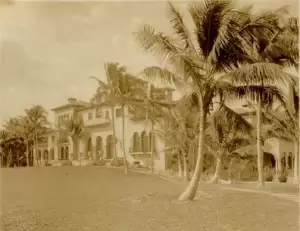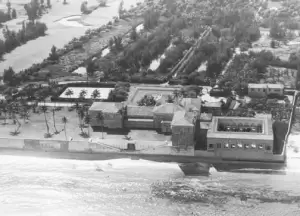The Great Architects: Mizner in Palm Beach

The busy social life of Palm Beach gradually moved out of the grand hotels as seasonal residents built grand houses in which they did their entertaining. Although several architects are credited with creating Palm Beach’s Mediterranean Revival style, during the 1920s Addison Mizner was the leading architect not only in Palm Beach, but also in Florida. He designed 67 structures in Palm Beach, 27 in Boca Raton, and ten elsewhere in Palm Beach County. Mizner’s first Palm Beach design was El Mirasol, which began the look that distinguishes the town today, incorporating tiled roof towers and turrets, sheltered cloisters, and paneled rooms. Mizner’s flowing floor plans opened onto patios and terraces, with stone fountains gracing the grounds. Edward T. Stotesbury’s wife, Eva, grande dame of Palm Beach society in 1919, asked Mizner to design their oceanfront mansion at 348 North County Road after seeing his design of the Everglades Club.
Mizner’s next two commissions were Charles A. Munn’s Casa Amado at 455 North County Road and his brother Gurnee’s Louwana (for his wife, Mary Louise Wanamaker) next door. Charles bought the land from the Phipps’ and gave some of it to Gurnee, according to their younger brother, Ector, and they built “rather identical” houses, with a shared driveway. Casa Amado remained in the family until 2003 and was heavily damaged by fire in 2007 during renovations.
In 1922 Mizner designed the oceanfront Casa Bendita for John S. Phipps and his wife Margarite “Dita” Grace, (for whom the house was named) and Via Mizner on Worth Avenue, which revolutionized Palm Beach shopping.
Retail tycoon Rodman Wanamaker II hired Mizner to build La Guerida (“bounty of war”) in 1923 for about $50,000, and sold it to Joseph P. Kennedy in 1933 for $120,000. Joseph and Rose Kennedy had nine children. They attended St. Edward Catholic Church and the younger generations were frequent visitors at Green’s Pharmacy’s lunch counter. John F. Kennedy and his family stayed at the house; it became known as the Winter White House during his presidency.
Mizner built his own first house at 720 South Ocean Boulevard and sold it within a year to Harold Stirling Vanderbilt, who then had Mizner add on to it; architect Maurice Fatio added to it also. When the Town of Palm Beach refused to allow the road in front of his house to be abandoned after it was damaged in the 1928 hurricane, he hired Maurice Fatio to design a new house for him on the beach at Manalapan.

Playa Riente was Mizner’s largest and most elaborately decorated home in Palm Beach, built in 1923 for Oklahoma oilman Joshua Cosden. Its entrance hall, inspired by the Stock Exchange in Valencia, Spain, was almost 60 feet long and 30 feet high.
To obtain the European styles he needed, Mizner established a group of workshops to make his own furniture and other materials: clay roof tiles, furniture, cast stone, forged iron, pottery, and stained glass. Originally financed by Paris Singer during construction of the Everglades Club, the workshops became Mizner Industries, Inc., one of the largest manufacturing firms in Palm Beach County during the 1920s. On Bunker Road, West Palm Beach, the firm produced furniture “fashioned after designs that Mr. Mizner had originated” and “distinctive copies of antiques,” which were often distressed to give them an aged look. In partnership with Woodlite, Inc., Mizner sold reproduction “wood” paneling nationwide; other facilities were in Kelsey City (now Lake Park).
Mizner: The Man
At six-foot-three and 300 pounds, Addison Mizner was a memorable character. He owned a pet monkey, Johnnie Brown, who is buried near Mizner’s former apartment in Via Mizner off Worth Avenue. The dog of a subsequent owner lies beside Johnnie, in the only known graveyard in Palm Beach.

